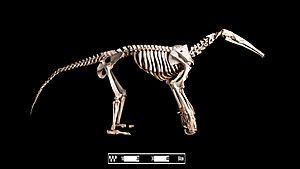Knuckle-walk facts for kids

Knuckle-walking is a special way some animals move on land. Instead of walking flat on their hands or paws, they curl their fingers or front toes. They then walk on the bony part of their front foot, which is called the knuckle.
Animals like Gorillas, chimpanzees, anteaters, and platypuses use knuckle-walking. They often do this because their hands or front paws have a special shape for doing something very different from just walking.
Contents
Why Do Animals Knuckle-Walk?
Many animals knuckle-walk because their front paws are designed for tasks other than just walking.
Hands for Tools and Food
Apes like gorillas and chimpanzees use their hands to hold food and use tools. Because their hands have fingers, they curl them up when they walk on their knuckles. This protects their fingers and allows them to move around easily on the ground.
Paws for Digging

Anteaters, especially large ones like the giant anteater, use their front paws to dig for ants and termites. Their strong claws are perfect for breaking into nests. When they walk, they curl these digging claws under their paws. This keeps the sharp claws from getting in the way or getting damaged. Smaller anteaters that live in trees usually do not knuckle-walk.
Webbed Feet for Swimming
Platypuses have unique front paws with webbed toes that are great for swimming. When they are on land, they curl their webbed toes under. This way, the webbing does not get in the way of walking. It also protects their webbed feet from getting hurt on rough ground.
How Gorillas and Chimpanzees Knuckle-Walk
Gorillas and chimpanzees both knuckle-walk, but they do it a little differently.
Chimpanzee Movement
Chimpanzees spend more time in trees than gorillas do. Because of this, their wrists can turn in many different ways. This flexibility helps them climb and swing through branches. When they knuckle-walk on the ground, their wrists might bend in various directions.
Gorilla Movement
Gorillas usually keep their wrists straight when they knuckle-walk. Their bodies are very strong and adapted for moving around in trees, even though they spend a lot of time on the ground. Their arms are longer than their legs, and their middle body is shaped like a cone.
The bones in their arms are also very good for knuckle-walking. For example, the radius bone in their forearm can lock into one of the bones in their wrist. This strong connection helps their arm and wrist bones hold the animal's weight as they move. Human arm and wrist bones do not have this special locking ability.
Knuckle-Walking and Human Ancestors
Sometimes in movies or cartoons, fictional cavemen are shown knuckle-walking or dragging their long arms on the ground. However, scientists are still debating whether early human ancestors really knuckle-walked in the same way gorillas do today.
Some scientists believe that humans evolved from an ancestor that lived in trees, similar to chimpanzees. They look at the way our wrist bones are shaped to support this idea. Other scientists have suggested that some extinct relatives of humans, like Australopithecus anamensis and Australopithecus afarensis, might have knuckle-walked. This is an interesting area of study as scientists continue to learn more about how humans evolved.

